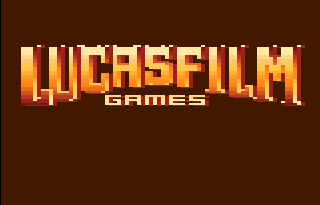 |
 |
Ballblazer |
Ballblazer was one of the first titles from Lucasfilm's Games Division and was popular on other systems such as the Atari 5200 and Commodore 64, but really shines on the 7800. Why? This 1987 release was sorely needed by the 7800 as it adds some depth to the rather skimpy lineup of cartridges for the system. Sure, the Commodore had a ton of titles out there, as did the 5200. The same was not true of the 7800.
Sports titles for the 7800 were, after all, few and far between. Ballblazer is a rather crude form of soccer that helped fill that void. And, better yet, Ballblazer is a good sports game that will appeal to people that care little about that genre. The emphasis here is on fast, simple gameplay and relies on quick decisions and learning the subtle nature of the game more than it does on strategy. Also, the 7800 has a reputation for offering some fantastic ports of arcade games, but few original titles of any quality. Ballblazer is a very quirky title for the 7800 that's more than another "shooter" or "maze game" for the console.
Ballblazer is set in the year 3097 and centers around a game in which each player steers a Rotofoil hovercraft on a field that resembles a large, green checkerboard. The object of the game is to grab the Plasmorb (the "ball" in the game) and get into position to either kick it or drive it into a goal. That's a simple concept, but addictive enough to cause one to play over and over again.
The beauty of the game has to do with the split screen view afforded the player. Each player, through the use of the split-screen, is able to view the action from the perspective of his Rotofoil, thus offering an independent view of the field. So, you might see that you have the Plasmorb and are racing toward the goal, or you might be shocked to see your opponent is steering his craft for an easy score. This view, of course, is perfect for multiplayer matches.
Also, the game is written so that the players don't get "lost" on the field. If your opponent has the Plasmorb, then your Rotofoil will automatically turn to face the ball. If you have the Plasmorb, then your Rotofoil will turn toward the goal.
The goal itself adds a wrinkle to the game. Specifically, it moves slowly across the field and the posts on each side of the goal move closer together, thus making it more difficult to shoot the Plasmorb for a score. Various points are given for how far one is away from the goal when the Plasmorb is shot into it (just running the ball into the goal is worth one point, while getting off a lucky shot and scoring when the goal isn't even in sight is worth three). Naturally, the player with the most points at the end of the game wins.
Graphically, this game is downright pretty. The playing field is a simple, green checkerboard and the goal posts are pink. The graphics, however, are nice and sharp, and the animation is very fast and smooth in the game. Forget about jerky landscapes and flickering characters on this game. Everything is rock solid and the playfield scrolls along beautifully. In fact, this is one of the few games that actually looks as pretty as the screen shots suggest.
The only problem I have with the graphics concerns the color of the Rotofoils. "Player 1" has a pink Rotofoil, while "Player 2" has an orange one. Neither of those colors would have been my first choice as they are rather loud and a touch ugly by nature. However, the color of the Rotofoils does provide a nice contrast to the green playing field and the yellow Plasmorb.
The sound here is excellent, too. The background music consists of a bunch of swirling keyboards that sound like they came straight out of a mid-level, science fiction movie. Basic sounds are also evident when one catches the Plasmorb, tries to steal it from the opposing player or shoots a goal. The sound effects are subtle enough to stay in the background and not become irritating, but they provide a nice atmosphere for the game.
Now, the thing that really ties the great graphics and excellent concept together is the actual gameplay. You can choose to play against a computer drone, and there are nine levels of difficulty that run from the stupid drone my five-year-old son could destroy all the way to one that's almost impossible to beat.
My favorite way to play this game, however, is with another human opponent. My wife and I have spent many an hour beating each other's brains in at this, and the temptation is always there to start it up again after a game ends. Fortunately, the games are short -- the length of each match can be set from one to nine minutes, but the default of three minutes strikes me as the perfect length.
If you have an Atari 7800, you owe it to yourself to pick up a copy of this game. This is one of the prettiest and most enjoyable games available on the system, and the cartridge is so common that it can be had for very little money. Out of all the 7800 titles I've purchased through the years, this is the one that stays at or near the top of the pile.
 Lucasfilm Games eventually changed their name to LucasArts and still produce games for popular platforms today.
Lucasfilm Games eventually changed their name to LucasArts and still produce games for popular platforms today.| Name: | |
| Subject: | |
| Comment: | |
| Check: | What is the greatest video game company of all time? (Hint: Atari.) |